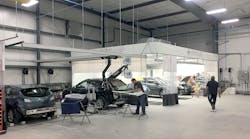Body shops and collision centers today often find themselves pulled in many directions and faced with pressure to decrease key-to-key time to satisfy insurance partners, increase revenue and produce high-quality repairs. In today’s fast-paced repair environment, operating inefficiently can have a negative impact on all three of these important objectives. By selecting tools to substantially decrease curing times and implementing the right process flow around the equipment, your shop can meet its production goals while increasing profit.
The Right Tools
An excellent way to increase your shop’s throughput is by implementing infrared curing technology into your body repair and painting processes. By rapidly curing body filler, primer and top coatings, IR systems can reduce repair times by hours and free up your technicians to work on other projects.
There are a variety of IR curing products on the market — from electric to gas catalytic, and small handheld units to full-arch systems that are designed to cure an entire vehicle. It can be difficult to discern amongst these products. When selecting an IR system for your shop, it’s important to first make sure you understand how the technology works.
Electric IR and gas catalytic IR differ significantly in how they dry filler and coatings. Electric IR produces short wave energy, which penetrates directly to the substrate to cure from the inside out, for a fast, complete cure. This allows for high-quality repairs in a very short amount of time. Electric IR units also heat up almost instantly and cool down rapidly for safe working conditions.
On the other hand, gas catalytic systems generate primarily medium wave, along with some long wave IR. With medium wave energy, each layer of coating must be dried individually, resulting in a longer drying process. Gas catalytic IR systems also must be preheated before they can be used. To get around this, many shops leave their gas catalytic IR systems on all day, creating a potential safety hazard for employees as well as high energy costs.
Pat O’Neill, a prominent shop owner and business partner of Bodyshop Revolution, has long been an advocate for emerging technologies, including IR curing systems. After initially investing in gas catalytic IR systems for his businesses, O’Neill has shifted his endorsement to GFS’ electric REVO Accelerated Curing Systems.
“Given the benefits of short wave over medium wave IR, and the energy savings associated with electric over gas, REVO Systems are more versatile in application,” said O’Neill. “They also aren’t hindered by proprietary equipment requirements; you could retrofit any REVO System into most existing paint booths and see excellent results.”
Service and Support You Can Count On
In addition to looking at how the IR systems operate, shops should also be aware of how the IR curing company you select handles service and support, and what kind of access you will have to replacement parts. If anything were to happen to your IR system or should you just need new bulbs or have an operating question, you want to know that someone will be available to help you get your unit back up fast.
“If used effectively, both gas and electric IR can decrease cure times and increase throughput,” O’Neill says. “But in the long run, the competition’s products lack access to the service and parts that make operating these technologically advanced systems possible.”
Since REVO Systems are backed by GFS’ technical services department and extensive distribution network, customers have access to quality service and support. Compared to gas catalytic systems, the electric IR REVO Systems have simpler mechanics, which not only gets shops up and running faster, but provides fewer failure points and less repairs. Additionally, replacement parts for REVO Systems are stocked in several metropolitan hubs across the U.S., while the competition’s parts must be ordered and stocked in advance by shop owners or shipped from overseas, increasing costly downtime.
With a full line of products, which includes smaller mobile units (REVO Handheld and REVO Spot), REVO Systems also require a significantly lower initial investment than most gas infrared curing systems.
Shop Processes Designed to Maximize Your Profits
Implementing IR curing technology in your shop can go a long way in improving throughput and cutting down on cure time, but it will not eliminate every bottleneck in your shop. According to O’Neill, purchasing a REVO System is a great start, but to get “the biggest bang for your buck,” you should also implement efficient processes around that equipment. O’Neill has spent the past three years helping shop owners move vehicles through their shops as efficiently as possible. His philosophy has four key strategies:
- Consolidate Departments to Reduce Time: Department differentiation creates lines — both physically and in communication — that lengthen cycle times. Consider consolidating departments and responsibilities wherever possible. For example, one technician could prep, prime and sand projects to ensure a continuous workflow, maximize space and eliminate downtime.
- Eliminate Estimating Mistakes: If mistakes are made while estimating and incorrect parts are ordered (or parts are missed), the car will sit in your shop waiting for parts. O’Neill recommends that estimators take the time needed to verify that the estimate is written properly and the correct parts are ordered. Knowing when all the parts will arrive enables you to more precisely schedule production and spread work evenly over the days the shop is open. Additionally, if the car is in drivable condition, have the customer continue driving it until all the parts have arrived at your shop. This drastically reduces key-to-key time and keeps insurance billing time to a minimum.
- Decrease Cure Time: By quickly curing fillers and coatings from the inside out, REVO Accelerated Curing Systems can increase your paint shop throughput by up to 80 percent. REVO’s lamps reach full temperature in less than a second, eliminating the need to preheat the system. While in use, REVO Systems can fully cure coatings on metal and plastic surfaces in a matter of minutes, which surpasses traditional paint booth bake cycle times and is safe for all types of vehicles, even electric cars. When you are done using your REVO System, the lamps cool down shortly after they are turned off.
- Affect the Shop’s Culture and Belief System: O’Neill and his team meet with the owners and key stakeholders of the shop, train the entire team on the new process flow and teach them how the equipment can be used most efficiently. Technicians gain familiarity with the process from start-to-finish, as well as understand the reason and value behind each of the steps.
Combining the right equipment with efficient processes can save money, substantially increase throughput and maximize your shop’s insurance payout potential. With the help of GFS’ REVO Accelerated Curing Systems and Pat O’Neill’s consulting services, you can decrease your cure times and increase shop revenue, while improving the quality of your repairs.
For more information about REVO Systems or Pat O’Neill’s consulting services, visit globalfinishing.com.



